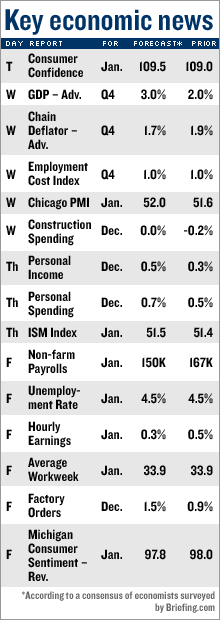Stocks: Everything hits at onceInvestors gear up for a big week. Events include the Federal Reserve's policy meeting, the January jobs report and earnings from nearly one-fourth of the S&P 500.NEW YORK (CNNMoney.com) -- Wall Street is set to end a choppy first month of the year with a one-two-three punch: a Fed policy meeting, a monthly jobs report and earnings from one-fourth of the 500 largest publicly-traded companies. And that's not all. In the first week of the new year to bring both an onslaught of economic and corporate news, readings are also due on gross domestic product growth, consumer confidence and the manufacturing sector of the economy. Also in the mix: oil prices, which slipped at least 10 percent in the first half of the month before rebounding during the last week. Stocks struggled last week as investors contended with that rebound in oil prices, some disappointment about the fourth-quarter earnings and a growing realization that the Federal Reserve may not push interest rates one way or the other this year. "I think the general bias will remain positive, but I don't think stocks can really move a lot higher until we get clarity on when the Fed is going to move one way or the other," said Charles Smith, chief investment officer at Fort Pitt Capital Group. He said that such clarity may not emerge for at least six months. At the very least, it is unlikely to emerge following next week's Federal Reserve policy meeting. Although perhaps the most anticipated market event of the week, the Fed policy meeting is not likely to yield any surprises for investors. The central bank, meeting Tuesday and Wednesday, is widely expected to keep the Fed funds rate, a key short-term interest rate, steady at 5.25 percent, as it has done for the last four policy meetings. The Fed boosted interest rates 17 straight times between the summer of 2004 and the summer of 2006, to help slow the rapidly growing economy and combat inflation. The bank opted to pause in August 2006, and stocks gained through the end of the year partly on hopes that the bank's next move would be to cut rates. But that is unlikely, economists say, and is certainly not likely to happen soon, even with the recent decline in oil prices and stronger batch of economic news. The Fed's closely watched statement Wednesday is likely to maintain the bankers' recent view that the economic slowdown is helping to reduce inflation, but that pricing pressures still remain. "I think it's going to be a very plain, vanilla statement," said Joshua Shapiro, chief economist at Maria Fiorini Ramirez, Inc. "They aren't likely to do anything in the foreseeable future, which is what they've been saying publicly for a while." Shapiro said that the bankers will likely acknowledge the recent decline in oil prices, but that it won't change their communication. However, he noted that stock and bond investors are likely anticipating the steady-as-she-goes approach. Therefore investors are unlikely to be ruffled by a lack of change, beyond a typical knee-jerk reaction. The fourth-quarter GDP report Wednesday, however, could throw a few curves, he said. "It's a difficult one to predict because the reads on inventories and exports move around a lot," Shapiro said. In addition, this is the preliminary read on the fourth quarter, later to be advised. At the end of the week, investors get the January jobs report, which should show continued solid growth in payrolls. Where the report could threaten stock gains is if average hourly earnings - the report's inflation component - shows a bigger-than-expected decline. (See chart for details.) Earnings onslaught to continue In the week ahead, 112 of the 500 largest publicly traded companies report results, including tech leaders Google (Charts) and Amazon.com (Charts) and Dow components Verizon (Charts), Pfizer (Charts), and Merck (Charts). Dow component Exxon Mobil (Charts) is also expected to report, along with a handful of other big oil companies. (See chart for details.) After leading the charge in recent quarters, energy-sector earnings growth is expected to have slowed in the just-completed fourth quarter. According to Thomson Financial, energy-sector earnings are expected to have declined 11 percent in the quarter, marking the first quarter of contraction in several years. That's not the only dubious record expected to be hit. Overall, S&P 500 earnings are forecast to have grown 9.9 percent from the first quarter, according to Thomson Financial, marking the first period of less than 10 percent growth for the benchmark index in nearly five years. Standard & Poor's takes a more conservative approach, looking for earnings to grow just 8 percent in the December quarter. For both earnings-tracking companies, the current forecast is a blended one, representing both reported and expected earnings. "After 18 consecutive quarters of double-digit growth, earnings are going to slow, and investors need to get used to that," said Howard Silverblatt, equity market analyst at Standard & Poor's. However, he points out that the slowdown is largely about tougher comparisons after a period of such consistent expansion. Additionally, the slowing economy and decline in energy- sector earnings play a role in slower overall growth. So far, about 40 percent of companies in the S&P 500 have reported results, and, as is typical, roughly two-thirds of the companies have been posting higher-than-expected results. Yet stock investors have been more preoccupied with high-profile companies that have reported weaker earnings for the December quarter or issued milder-forecasts for the March quarter, the first of 2007. They include Intel (Charts), Apple (Charts) and AMD (Charts). First-quarter earnings forecasts have been pretty conservative so far. Growth is expected to grow at a 5.8 percent rate, said Thomson research analyst David Dropsey, meaning the quarter is likely to bring another multi-year low. On the upside, it's only one month into the quarter, Dropsey noted, and the overall growth forecast is typically revised up by a few percentage points between this point and the quarter's end. |
|


